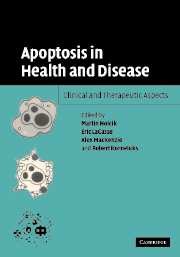Book contents
- Frontmatter
- Contents
- List of contributors
- Preface
- 1 Apoptosis in health, disease, and therapy: overview and methodology
- 2 Developmental apoptosis in health and disease
- 3 Apoptosis and cancer
- 4 Neuronal cell death in human neurodegenerative diseases and their animal/cell models
- 5 Apoptosis in the cardiovascular system: incidence, regulation, and therapeutic options
- 6 Cytotoxic lymphocytes, apoptosis, and autoimmunity
- 7 Pro- and anti-apoptotic strategies of viruses
- Index
- Plate section
- References
2 - Developmental apoptosis in health and disease
Published online by Cambridge University Press: 03 March 2010
- Frontmatter
- Contents
- List of contributors
- Preface
- 1 Apoptosis in health, disease, and therapy: overview and methodology
- 2 Developmental apoptosis in health and disease
- 3 Apoptosis and cancer
- 4 Neuronal cell death in human neurodegenerative diseases and their animal/cell models
- 5 Apoptosis in the cardiovascular system: incidence, regulation, and therapeutic options
- 6 Cytotoxic lymphocytes, apoptosis, and autoimmunity
- 7 Pro- and anti-apoptotic strategies of viruses
- Index
- Plate section
- References
Summary
Introduction
Animal development starts from a single fertilized cell which subsequently multiplies and grows into an elaborate adult body. Amid such massive growth, negative regulation of growth plays an important role in orchestrating the development of intricate body structures. Programmed cell death is an integral part of such negative regulation, important in sculpting body parts, eliminating unnecessary cells, controlling organ size and cell number, proper wiring of the nervous system, and development of the immune system.
Historically, developmental biology has played a pivotal role in forming the basic concepts of programmed cell death. Soon after cells were discovered more than a century and half ago, Vogt observed that cell death occurs in a predictable pattern during amphibian metamorphosis, such as the disappearance of tadpole tails through cell death (Vogt, 1842). In 1951, Glücksmann had proposed a radical hypothesis that cell death might be an active part of development (Glücksmann, 1951). He suggested three distinct functions of apoptosis: (1) deleting unneeded structures (phylogenetic cell death); (2) controlling cell number (histogenetic cell death); and (3) sculpting structures (morphogenetic cell death). Later, the term “programmed cell death” was coined to describe a predicted pattern of cell death associated with insect metamorphosis (Lockshin and Williams, 1964). The evidence that new protein synthesis is required to trigger programmed cell death came in an experiment during which it was shown that treatment with cycloheximide, a protein synthesis inhibitor, blocked tadpole tail cell death during frog metamorphosis (Tata, 1966).
- Type
- Chapter
- Information
- Apoptosis in Health and DiseaseClinical and Therapeutic Aspects, pp. 49 - 74Publisher: Cambridge University PressPrint publication year: 2005
References
- 1
- Cited by



